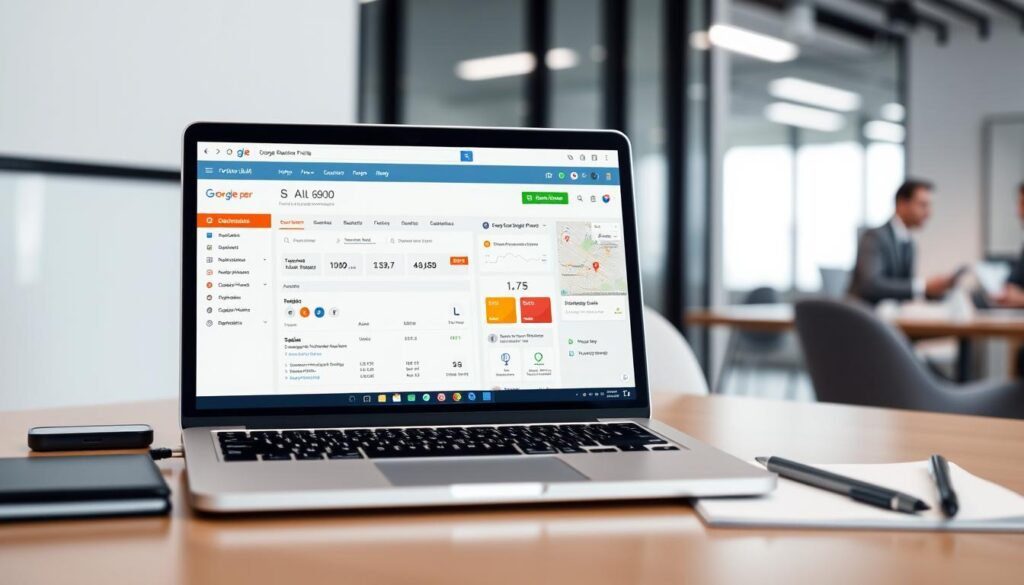Did you know 97% of homeowners look online before hiring an HVAC company? If your business isn’t easy to find, you’re missing out on thousands in potential revenue. With 75% of users never scrolling past the first page of results, ranking high is no longer optional—it’s essential.
At Macro Webber, we specialize in cultivating solutions to transform business. Our data shows HVAC companies leveraging smart digital strategies see up to 3,830% more traffic. This guide unpacks actionable tactics to boost your online presence, from mobile-first designs to local service dominance.
Key Takeaways
- Nearly all homeowners search online for HVAC services before deciding.
- First-page rankings are critical—most users don’t explore further.
- Mobile optimization drives emergency service inquiries.
- Tailored strategies can skyrocket traffic and leads.
- Local SEO is non-negotiable for HVAC businesses.
Why Search Everywhere Optimization Matters for HVAC Businesses
Google’s local results decide which HVAC companies get calls. With 97% of homeowners researching online, your digital presence directly impacts lead generation. If you’re not visible where potential customers look, you’re missing opportunities.
Local Pack Dominance and Lead Conversion
Google’s local pack displays three businesses for local searches. HVAC companies in this spot get 44% of clicks. Mobile searches for emergencies drive 60% of service calls, often via “near me” queries.
Here’s how different lead sources compare:
| Lead Source | Conversion Rate | Avg. Cost per Lead |
|---|---|---|
| Google Local Pack | 28% | $22 |
| Traditional Ads | 12% | $45 |
| Directories | 18% | $30 |
ServiceTitan reports 3.3 million HVAC leads come from SEO annually. Reviews also matter—businesses with 50+ ratings see 30% higher click-through rates.
Voice search amplifies this. Featured snippets answer 40% of queries like “best AC repair near me.” Local citations (mentions on other sites) boost your domain authority, helping you rank higher.
Master Strategic Keyword Research
Strategic keyword selection drives targeted traffic to your business. Identifying high-intent phrases ensures your content reaches customers actively seeking solutions. Start by analyzing what your audience types into search engines.
Free vs. Paid Tools for Precision
Google’s Autocomplete and “People Also Ask” boxes reveal popular queries for free. For deeper insights, tools like SEMrush track volume and competition. Paid options excel for competitor analysis and trend forecasting.
Long-tail keywords like “emergency AC repair Chicago” attract ready-to-buy customers. Seasonal terms (e.g., “furnace tune-up”) align with demand spikes. Map location-based phrases if you serve multiple areas.
Competitor Gaps and Intent Matching
Use SEMrush to spy on rivals’ top-performing terms. Build an “HVAC service + problem + solution” matrix to cover all intent types. Avoid stuffing—Google’s E-E-A-T guidelines penalize unnatural density.
Macro Webber’s dashboard tracks keyword performance in real time. Focus on phrases that convert, not just rank. Your marketing efforts should mirror how customers describe their needs.
Optimize Your Google Business Profile
Your Google Business Profile (GBP) is the digital storefront for your HVAC business. Over 80% of customers check it before calling. A complete profile boosts visibility and trust, directly impacting lead conversion.
Essential Elements for HVAC Listings
Start with the basics: business name, phone number, and address (NAP). Inaccurate NAP details hurt rankings. Use your exact service area (e.g., “Chicago Metro”) to avoid misdirected queries.

Choose categories wisely. “HVAC Contractor” covers general services, while “Air Duct Cleaning” targets niche needs. Google allows up to 10 categories—mix broad and specific.
Photos and videos matter. Businesses with 100+ images get 42% more requests. Upload before/after repairs, team shots, and equipment close-ups. A case study showed a 40% lead increase after adding videos to GBP.
Leverage Posts and Reviews
Schedule GBP posts for seasonal promotions (e.g., “Spring AC Tune-Up Specials”). These appear in searches for 7 days. Use geo-targeted keywords like “24/7 furnace repair in [City]” in your description.
Respond to all reviews—positive or negative. A template for professionalism:
“Thank you for your feedback, [Name]. We’re glad we could help with your [service]. For urgent needs, call [phone number] anytime.”
Avoid Common Pitfalls
Keyword-stuffed business names (e.g., “Best HVAC Repair Chicago LLC”) violate guidelines. Stick to your legal name. Ensure NAP consistency across directories like Yelp and HomeAdvisor.
Set your service radius accurately. Too broad, and you’ll get irrelevant leads. Too narrow, and you miss nearby opportunities. Sync GBP with ServiceTitan to track Local Services Ads performance.
Create HVAC-Focused Quality Content
Homeowners actively seek solutions to HVAC problems—your content should answer them. Educational articles like “How to Change AC Filter” build trust and drive conversions better than sales pitches.
Build Problem-Solving Frameworks
Develop these four content pillars:
- Maintenance: Guides like seasonal checklists.
- Repair: Troubleshooting common issues.
- Installation: Cost vs. benefit comparisons.
- Efficiency: Energy-saving tips.
Repurpose blog posts into YouTube videos. For example, turn “Top 10 Signs You Need Furnace Service” into a 2-minute explainer. This expands your reach across platforms.
Leverage Structured Data
Implement FAQ schema to capture featured snippets. For voice search, optimize for queries like *”24/7 AC repair near me*”. Tools like Macro Webber’s BTU calculator boost engagement.
| Content Type | Avg. Engagement | Lead Conversion |
|---|---|---|
| How-To Guides | 3.2 mins | 18% |
| Checklists | 2.1 mins | 12% |
| Video Tutorials | 4.5 mins | 25% |
Refresh outdated posts annually. Heat maps show interactive tools (e.g., load calculators) keep visitors on websites 40% longer. Avoid duplicate service pages—Google penalizes copied text.
Speed Up Your HVAC Website
Slow-loading websites frustrate customers and hurt rankings—here’s how to fix it. Google’s Core Web Vitals now directly impact search positions. HVAC companies lose 53% of mobile visitors if pages take over 3 seconds to load.
Essential Technical Fixes
Start by analyzing your Core Web Vitals in Google Search Console. Focus on three metrics:
- Largest Contentful Paint (LCP): Should load under 2.5 seconds.
- First Input Delay (FID): Aim for
- Cumulative Layout Shift (CLS): Keep visual stability below 0.1.
Image Compression Made Simple
Use tools like *TinyPNG* to shrink file sizes without quality loss. Follow these steps:
- Upload service gallery images (e.g., furnace repairs).
- Select 70% compression for JPEGs.
- Download optimized files and replace originals.
Hosting Solutions Compared
Shared hosting slows sites during traffic spikes. Managed WordPress plans offer:
| Feature | Shared Hosting | Managed WordPress |
|---|---|---|
| Speed | 1.8s avg. | 0.9s avg. |
| Uptime | 99.5% | 99.99% |
| Support | Basic | 24/7 Priority |
Implement lazy loading for service galleries. A Chicago HVAC company saw conversions jump 17% after cutting load times by 2 seconds.
Advanced Technical Tweaks
Audit legacy websites for:
- Broken redirects (use 301s for outdated service pages).
- Render-blocking JavaScript (defer non-critical scripts).
- Missing schema markup for local service areas.
“Mobile-first indexing means Google checks your mobile site first. Test with Chrome’s Lighthouse tool monthly.”
Build a Local Citation Network
Local citations act as digital signposts guiding customers to your business. These mentions of your company name, address, and phone number across directories help search engines verify your legitimacy. A consistent presence builds trust and improves rankings.

Essential Directories for Maximum Visibility
Start with these high-impact platforms:
- General directories: Yelp, HomeAdvisor, Angi
- Industry-specific: HVAC.com, FurnaceCompare
- Local hubs: Chamber of Commerce, BBB
For chamber listings, use this template:
“[Business Name] provides [services] to [location] residents since [year]. Contact us at [phone] for [value proposition].”
BBB Accreditation Process
Earning BBB accreditation involves:
- Submitting business information and documents
- Passing a standards review (takes 7-10 days)
- Maintaining A+ rating through customer resolution
Use BrightLocal to clean existing citations. The tool identifies inconsistencies in your NAP (Name, Address, Phone number) across 50+ directories. Fixing these can lift rankings by 15%.
Strategic Outreach for Citations
When requesting citations, personalize your email:
“Hi [Name], I noticed your directory features [local businesses] in [area]. Our HVAC company serves this community and would appreciate inclusion. Here’s our verified NAP: [details].”
Local sponsorships (little league teams, charity events) often include directory listings. These provide backlinks while supporting your community.
Technical Optimization Tips
Add schema markup for aggregate ratings. This displays star ratings in search results. Use Ahrefs to find unlinked mentions—contact these sites to convert them into proper citations.
Avoid low-quality directories that charge for submissions. These often hurt more than help. Stick to reputable platforms that customers actually use.
Monthly NAP audits prevent inconsistencies. Set calendar reminders to verify your details everywhere. This maintenance protects your hard-earned rankings.
Cultivate Positive Customer Reviews
Positive customer reviews are the lifeblood of your service business—they build trust and drive conversions. A 4.8-star average can increase bookings by 34%, making ethical review generation a priority.
Automate Requests with Templates
Use ServiceTitan’s Reputation Management to send post-service SMS or emails. Keep messages brief:
“Hi [Name], thanks for choosing us! How was your experience? Share your thoughts here: [Link].”
QR codes on technician tablets streamline in-person requests. Train staff to explain their purpose without pressuring customers.
Compliant Review Generation
Google prohibits incentives for reviews. Instead, focus on timing—ask when satisfaction is highest, like after a successful repair. Display guidelines in break rooms:
- Do: Request feedback via neutral language.
- Don’t: Offer discounts for 5-star ratings.
Respond Professionally to All Feedback
Template for negative reviews:
“We apologize for your experience, [Name]. Our team will contact you to resolve this. Call [number] for immediate assistance.”
Positive responses should include keywords like “24/7 furnace repair” for SEO.
| Platform | Response Time | Impact on Rankings |
|---|---|---|
| 48 hours | High | |
| Yelp | 72 hours | Medium |
Syndicate top reviews across your website and Google Ads extensions. A Dallas company saw 20% more clicks by showcasing testimonials in Local Services Ads.
Warning: Fake reviews trigger penalties. Use tools like ReviewMeta to audit authenticity. Regular staff training ensures compliance.
Earn Quality Backlinks
Backlinks serve as digital endorsements that boost your credibility with search engines. For service businesses, authoritative links from local partners and industry sites signal trust. A strong backlink profile can lift rankings by 25% or more.
Forge Local Partnerships
Collaborate with home improvement blogs for guest posts. Offer actionable tips like “5 Signs Your Ductwork Needs Repair” in exchange for a backlink. Suppliers and manufacturers often link to trusted installers—build those relationships.
Use this pitch template for trade publications:
“Hi [Editor], I’ve noticed your audience engages with [topic]. Our guide on [specific HVAC solution] could help readers. Here’s a draft: [Link]. Would this fit your editorial calendar?”
Create Link-Worthy Assets
Infographics on energy efficiency or seasonal maintenance attract shares. Tools like Canva simplify design. A Chicago company earned 50+ backlinks by visualizing furnace lifespan data.
Reclaim unlinked mentions with tools like Ahrefs. Reach out politely:
“Thanks for mentioning us in your [article]. Could you link to our [relevant page]? Here’s the URL: [Link].”
Leverage HARO and Sponsorships
Respond to HARO queries as an HVAC expert. Journalists need sources for stories like “Extreme Weather Home Prep.” Local event sponsorships (e.g., home shows) often include backlinks in digital programs.
Track progress in Google Search Console. Disavow toxic links if needed—but avoid low-quality directories entirely. A balanced strategy prioritizes quality over quantity.
Track Performance with SEO Analytics
Data-driven decisions separate thriving businesses from those guessing their next move. For HVAC companies, analytics reveal which strategies drive calls and conversions. Tools like Google Analytics and Search Console turn clicks into actionable insights.
Essential Metrics to Monitor
Focus on these key indicators:
- Service inquiries: Track form submissions and call clicks.
- Organic visibility: Measure impression share in search engines.
- Local rankings: Monitor fluctuations in the local pack.
Featured snippet positions matter—40% of voice searches use them. Custom dashboards simplify tracking. For example, a Chicago HVAC team boosted leads by 22% after spotting drop-offs on service pages.
Audit and Adjust Regularly
Quarterly health checks catch issues like broken links or slow-loading images. Compare organic vs. paid lead costs. UTM tags reveal which campaigns deliver the best results.
“Analytics aren’t just reports—they’re your roadmap to smarter marketing.”
Google Data Studio templates save hours. Set alerts for ranking drops to react fast. Consistent tracking ensures every optimization counts.
Conclusion: Implementing Search Everywhere Optimization for HVAC Growth
Dominating local results requires a proven SEO framework. The ten strategies outlined here work together to boost visibility and calls. Consistency matters—small daily improvements compound over time.
At Macro Webber, we specialize in transforming business performance. Our methodology delivers measurable results. Want to see where your site stands? Get a free audit at +91 (353) 405-7665 or hello@macrowebber.com.
Download our checklist to track progress. Advanced tactics like voice search optimization can further accelerate growth. Local markets move fast—stagnation means losing ground.
Start today. Each optimized element strengthens your digital foundation. Ready to outrank competitors? Let’s talk strategy.



